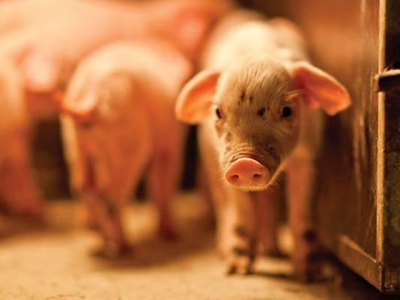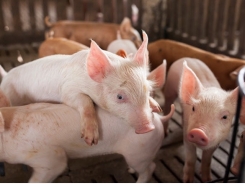Plasma as alternative to antibiotics in piglet diets

Science provides consistent results for efficient replacement of antibiotics by functional plasma proteins.
Spray-dried porcine plasma is considered a key ingredient for improving both growth performance and intestinal health in weanling pigs. kisstock | Photo: Fotolia
Over the past years, concerns have been raised about the use of antibiotics for mass (preventive) treatment and as growth promoting agents in livestock. Such overuse of antibiotics may contribute to the emergence of antimicrobial resistance, which could impair efficient treatment of bacterial diseases in humans and animals. Many products have been suggested as potential in-feed alternatives for non-therapeutic use of antibiotics. Among these, spray-dried plasma is considered one of the most promising alternatives, as is consistently shown in post-weaning piglet trials.
Antibiotic resistance
Antibiotics are valuable tools for reducing animal disease and suffering. Careful considerations have to be made whether, when, which and how antibiotics should be used. Antibiotics are overused in today’s agricultural practices, which consequences the emergence of bacteria that become increasingly ever more resistant to antibiotic treatment. This threat is not new, but recent studies have provided overwhelming proof that the situation is reaching a tipping point that necessitates a societal response.
Antibiotic resistance is a global issue, and international bodies such as the FAO, WHO and OIE have signed an agreement in 2012 to develop a tripartite initiative against the continuing rise in antibiotic resistant microbes. These leading bodies stress the need for a global holistic action and now collaborate with Ministers of Health and other associations to harmonize approaches. This involves a coordinated management of responsible use across the animal, food and human sectors in different geographic locations.
Use of spray-dried plasma as a natural alternative
Dietary spray-dried porcine plasma (SDPP) performs a role in reducing the need for antibiotics in swine feed by providing functional, health-promoting proteins to the gut.
Traditionally, weaning-associated problems have been treated with sub-therapeutic doses of antibiotics. Since the prohibition of the use of antibiotic growth promotors (AGPs) since January 2006, leading European research centers have made significant efforts to search for effective alternatives. However, alternatives equivalent to the efficiency of AGP’s prove to be difficult to find (Lallès et al., 2009). The major potential alternatives researched in Europe include organic acids, yeasts, essential oils, probiotics, prebiotics and SDPP.
Studies comparing dietary spray-dried animal plasma (SDAP) versus growth promoting antibiotics in feed consistently show equivalent and sometimes better results for SDPP (Coffey and Cromwell, 1995; Owusu-Asiedu et al., 2002, 2003; Torrallardona et al., 2002, 2003 and 2007; Bikker et al., 2004; Bosi et al., 2004; Conde, 2005; Pierce et al., 2005; Nofrarias et al., 2006). The nutrition provided by starter pig diets with plasma generally improves live weight (LW), average daily gain (ADG), average daily feed intake (ADFI), feed efficiency (gain to feed ratio; G:F), and morphology of the intestinal epithelium, and it reduces clinical disease and level of pro-inflammatory cytokines in response to infectious challenge (Table 1).
Studies comparing dietary spray dried animal plasma (SDAP) versus growth promoting antibiotics in-feed consistently show equivalent and somethimes better results for spray dried porcine plasma (SDPP).
Key ingredient for weanling pigs
A recently published study (Polo et al., 2014) investigated the ability of dietary SDPP to replace prophylactic in-feed antibiotics in a post-weaning piglet trial performed under commercial field conditions on a French farm. Piglets were weaned at 21 days of age and fed medicated feed (colistin, licomycin, and spectinomycin during the first week and colistin and chlortetracycline during weeks 2 and 3) or non-medicated feed containing SDPP (5 percent during the first week and 3 percent during weeks 2 and 3). Both approaches significantly improved overall post-weaning performance compared to the control. Although the overall effects were similar between SDPP and in-feed antibiotics, it appeared that the beneficial effects of diets with SDPP predominated during the first week post-weaning while the effects of in-feed antibiotics predominated during the second and third weeks.
However, for the whole study (21 to 42 days of age) there was no difference between the SDPP and medicated treatment groups in any of the performance parameters, and both groups had improved body weight and average daily gain compared with the control group without SDPP or antibiotics (Figure 1). These results are in line with other trial results showing equivalent post-weaning piglet performance when prophylactic antibiotics are replaced by dietary SDPP.

There was no difference between the SDPP and medicated treatment groups in any of the performance parameters; both groups improved body weight and average daily gain compared with the control group without SDPP or antibiotics.
In addition, as indicated by a study conducted by five outstanding European research centers and universities on pig research (Lallès et al., 2009), the supplementation of pig diets with SDPP is one of the best alternatives to prevent intestinal disorders at weaning. Spray-dried porcine plasma is therefore considered a key ingredient for improving both growth performance and intestinal health in weanling pigs, through which antibiotics used at this stage can be substantially reduced (Torrallardona, 2010).
References available upon request.
Related news
Tools

Phối trộn thức ăn chăn nuôi

Pha dung dịch thủy canh

Định mức cho tôm ăn

Phối trộn phân bón NPK

Xác định tỷ lệ tôm sống

Chuyển đổi đơn vị phân bón

Xác định công suất sục khí

Chuyển đổi đơn vị tôm

Tính diện tích nhà kính

Tính thể tích ao



 Piglet gut health and cow milk yields on…
Piglet gut health and cow milk yields on…  Formulating livestock diets without antibiotics: the cost issues
Formulating livestock diets without antibiotics: the cost issues